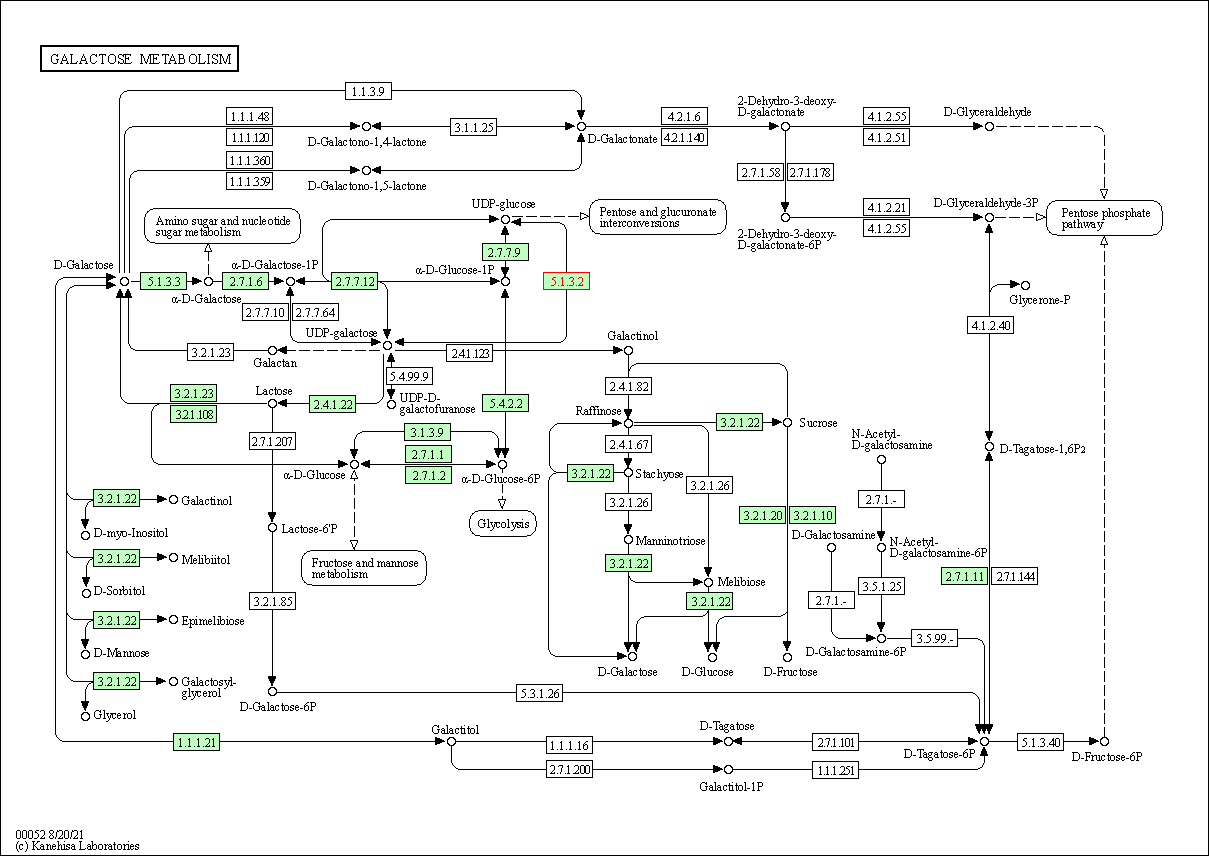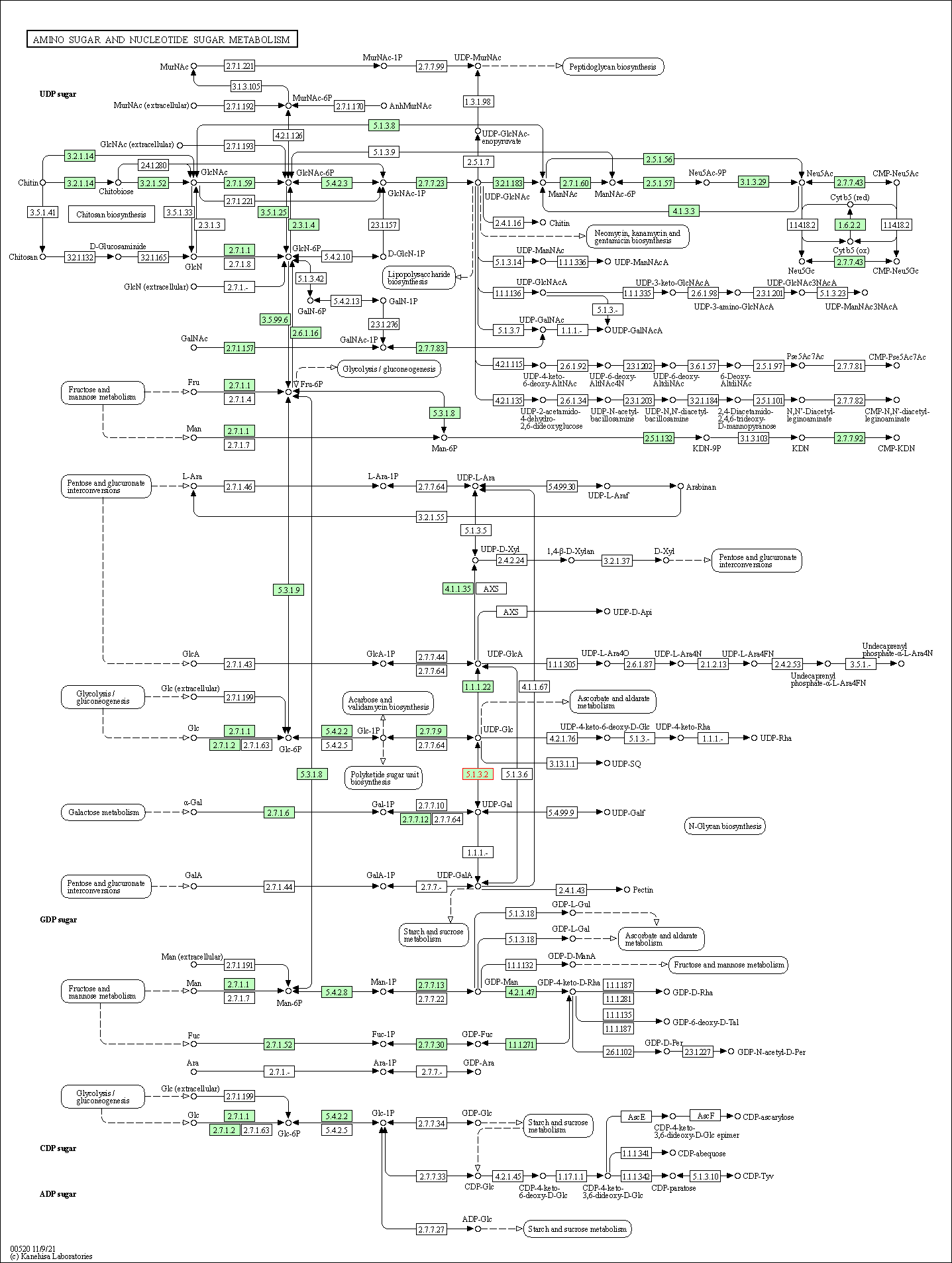Target Information
| Target General Information | Top | |||||
|---|---|---|---|---|---|---|
| Target ID |
T96014
(Former ID: TTDR00662)
|
|||||
| Target Name |
UDP-glucose 4-epimerase (GALE)
|
|||||
| Synonyms |
UDP-galactose4-epimerase; UDP-galactose4'-epimerase; UDP-galactose 4-epimerase; UDP-N-acetylglucosamine 4-epimerase; UDP-N-acetylgalactosamine 4-epimerase; UDP-GlcNAc 4-epimerase; UDP-GalNAc 4-epimerase; Galactowaldenase
Click to Show/Hide
|
|||||
| Gene Name |
GALE
|
|||||
| Target Type |
Literature-reported target
|
[1] | ||||
| Function |
The reaction with UDP-Gal plays a critical role in the Leloir pathway of galactose catabolism in which galactose is converted to the glycolytic intermediate glucose 6-phosphate. It contributes to the catabolism of dietary galactose and enables the endogenous biosynthesis of both UDP-Gal and UDP-GalNAc when exogenous sources are limited. Both UDP-sugar interconversions are important in the synthesis of glycoproteins and glycolipids. Catalyzes two distinct but analogous reactions: the reversible epimerization of UDP-glucose to UDP-galactose and the reversible epimerization of UDP-N-acetylglucosamine to UDP-N-acetylgalactosamine.
Click to Show/Hide
|
|||||
| BioChemical Class |
Racemases and epimerase
|
|||||
| UniProt ID | ||||||
| EC Number |
EC 5.1.3.2
|
|||||
| Sequence |
MAEKVLVTGGAGYIGSHTVLELLEAGYLPVVIDNFHNAFRGGGSLPESLRRVQELTGRSV
EFEEMDILDQGALQRLFKKYSFMAVIHFAGLKAVGESVQKPLDYYRVNLTGTIQLLEIMK AHGVKNLVFSSSATVYGNPQYLPLDEAHPTGGCTNPYGKSKFFIEEMIRDLCQADKTWNA VLLRYFNPTGAHASGCIGEDPQGIPNNLMPYVSQVAIGRREALNVFGNDYDTEDGTGVRD YIHVVDLAKGHIAALRKLKEQCGCRIYNLGTGTGYSVLQMVQAMEKASGKKIPYKVVARR EGDVAACYANPSLAQEELGWTAALGLDRMCEDLWRWQKQNPSGFGTQA Click to Show/Hide
|
|||||
| 3D Structure | Click to Show 3D Structure of This Target | PDB | ||||
| Cell-based Target Expression Variations | Top | |||||
|---|---|---|---|---|---|---|
| Cell-based Target Expression Variations | ||||||
| Drug Binding Sites of Target | Top | |||||
|---|---|---|---|---|---|---|
| Ligand Name: NADH | Ligand Info | |||||
| Structure Description | STRUCTURE OF HUMAN UDP-GALACTOSE 4-EPIMERASE COMPLEXED WITH NADH AND UDP-GLUCOSE | PDB:1EK6 | ||||
| Method | X-ray diffraction | Resolution | 1.50 Å | Mutation | No | [5] |
| PDB Sequence |
MAEKVLVTGG
10 AGYIGSHTVL20 ELLEAGYLPV30 VIDNFHNAFR40 GGGSLPESLR50 RVQELTGRSV 60 EFEEMDILDQ70 GALQRLFKKY80 SFMAVIHFAG90 LKAVGESVQK100 PLDYYRVNLT 110 GTIQLLEIMK120 AHGVKNLVFS130 SSATVYGNPQ140 YLPLDEAHPT150 GGCTNPYGKS 160 KFFIEEMIRD170 LCQADKTWNA180 VLLRYFNPTG190 AHASGCIGED200 PQGIPNNLMP 210 YVSQVAIGRR220 EALNVFGNDY230 DTEDGTGVRD240 YIHVVDLAKG250 HIAALRKLKE 260 QCGCRIYNLG270 TGTGYSVLQM280 VQAMEKASGK290 KIPYKVVARR300 EGDVAACYAN 310 PSLAQEELGW320 TAALGLDRMC330 EDLWRWQKQN340 PSGFGT
|
|||||
|
|
GLY9
3.358
ALA11
3.884
GLY12
3.203
TYR13
2.973
ILE14
2.856
GLY15
4.184
ILE32
4.701
ASP33
2.600
ASN34
3.114
PHE35
3.800
HIS36
3.126
ASN37
2.860
ALA38
3.490
MET65
3.604
ASP66
2.837
ILE67
3.104
LEU68
4.593
|
|||||
| Ligand Name: Nicotinamide-Adenine-Dinucleotide | Ligand Info | |||||
| Structure Description | HUMAN UDP-GALACTOSE 4-EPIMERASE: ACCOMMODATION OF UDP-N-ACETYLGLUCOSAMINE WITHIN THE ACTIVE SITE | PDB:1HZJ | ||||
| Method | X-ray diffraction | Resolution | 1.50 Å | Mutation | No | [6] |
| PDB Sequence |
AEKVLVTGGA
11 GYIGSHTVLE21 LLEAGYLPVV31 IDNFHNAFRG41 GGSLPESLRR51 VQELTGRSVE 61 FEEMDILDQG71 ALQRLFKKYS81 FMAVIHFAGL91 KAVGESVQKP101 LDYYRVNLTG 111 TIQLLEIMKA121 HGVKNLVFSS131 SATVYGNPQY141 LPLDEAHPTG151 GCTNPYGKSK 161 FFIEEMIRDL171 CQADKTWNVV181 LLRYFNPTGA191 HASGCIGEDP201 QGIPNNLMPY 211 VSQVAIGRRE221 ALNVFGNDYD231 TEDGTGVRDY241 IHVVDLAKGH251 IAALRKLKEQ 261 CGCRIYNLGT271 GTGYSVLQMV281 QAMEKASGKK291 IPYKVVARRE301 GDVAACYANP 311 SLAQEELGWT321 AALGLDRMCE331 DLWRWQKQNP341 SGFGT
|
|||||
|
|
GLY9
3.374
ALA11
3.797
GLY12
3.107
TYR13
2.898
ILE14
2.818
GLY15
4.196
ILE32
4.616
ASP33
2.657
ASN34
2.995
PHE35
3.653
HIS36
3.060
ASN37
2.843
ALA38
3.703
MET65
3.604
ASP66
2.769
ILE67
3.257
LEU68
4.728
|
|||||
| Click to View More Binding Site Information of This Target and Ligand Pair | ||||||
| Click to View More Binding Site Information of This Target with Different Ligands | ||||||
| Different Human System Profiles of Target | Top |
|---|---|
|
Human Similarity Proteins
of target is determined by comparing the sequence similarity of all human proteins with the target based on BLAST. The similarity proteins for a target are defined as the proteins with E-value < 0.005 and outside the protein families of the target.
A target that has fewer human similarity proteins outside its family is commonly regarded to possess a greater capacity to avoid undesired interactions and thus increase the possibility of finding successful drugs
(Brief Bioinform, 21: 649-662, 2020).
Human Tissue Distribution
of target is determined from a proteomics study that quantified more than 12,000 genes across 32 normal human tissues. Tissue Specificity (TS) score was used to define the enrichment of target across tissues.
The distribution of targets among different tissues or organs need to be taken into consideration when assessing the target druggability, as it is generally accepted that the wider the target distribution, the greater the concern over potential adverse effects
(Nat Rev Drug Discov, 20: 64-81, 2021).
Human Pathway Affiliation
of target is determined by the life-essential pathways provided on KEGG database. The target-affiliated pathways were defined based on the following two criteria (a) the pathways of the studied target should be life-essential for both healthy individuals and patients, and (b) the studied target should occupy an upstream position in the pathways and therefore had the ability to regulate biological function.
Targets involved in a fewer pathways have greater likelihood to be successfully developed, while those associated with more human pathways increase the chance of undesirable interferences with other human processes
(Pharmacol Rev, 58: 259-279, 2006).
Biological Network Descriptors
of target is determined based on a human protein-protein interactions (PPI) network consisting of 9,309 proteins and 52,713 PPIs, which were with a high confidence score of ≥ 0.95 collected from STRING database.
The network properties of targets based on protein-protein interactions (PPIs) have been widely adopted for the assessment of target’s druggability. Proteins with high node degree tend to have a high impact on network function through multiple interactions, while proteins with high betweenness centrality are regarded to be central for communication in interaction networks and regulate the flow of signaling information
(Front Pharmacol, 9, 1245, 2018;
Curr Opin Struct Biol. 44:134-142, 2017).
Human Similarity Proteins
Human Tissue Distribution
Human Pathway Affiliation
Biological Network Descriptors
|
|
|
Note:
If a protein has TS (tissue specficity) scores at least in one tissue >= 2.5, this protein is called tissue-enriched (including tissue-enriched-but-not-specific and tissue-specific). In the plots, the vertical lines are at thresholds 2.5 and 4.
|
| KEGG Pathway | Pathway ID | Affiliated Target | Pathway Map |
|---|---|---|---|
| Galactose metabolism | hsa00052 | Affiliated Target |

|
| Class: Metabolism => Carbohydrate metabolism | Pathway Hierarchy | ||
| Amino sugar and nucleotide sugar metabolism | hsa00520 | Affiliated Target |

|
| Class: Metabolism => Carbohydrate metabolism | Pathway Hierarchy | ||
| Degree | 7 | Degree centrality | 7.52E-04 | Betweenness centrality | 3.41E-04 |
|---|---|---|---|---|---|
| Closeness centrality | 1.51E-01 | Radiality | 1.20E+01 | Clustering coefficient | 2.38E-01 |
| Neighborhood connectivity | 4.43E+00 | Topological coefficient | 2.26E-01 | Eccentricity | 12 |
| Download | Click to Download the Full PPI Network of This Target | ||||
| Chemical Structure based Activity Landscape of Target | Top |
|---|---|
| Drug Property Profile of Target | Top | |
|---|---|---|
| (1) Molecular Weight (mw) based Drug Clustering | (2) Octanol/Water Partition Coefficient (xlogp) based Drug Clustering | |
|
|
||
| (3) Hydrogen Bond Donor Count (hbonddonor) based Drug Clustering | (4) Hydrogen Bond Acceptor Count (hbondacc) based Drug Clustering | |
|
|
||
| (5) Rotatable Bond Count (rotbonds) based Drug Clustering | (6) Topological Polar Surface Area (polararea) based Drug Clustering | |
|
|
||
| "RO5" indicates the cutoff set by lipinski's rule of five; "D123AB" colored in GREEN denotes the no violation of any cutoff in lipinski's rule of five; "D123AB" colored in PURPLE refers to the violation of only one cutoff in lipinski's rule of five; "D123AB" colored in BLACK represents the violation of more than one cutoffs in lipinski's rule of five | ||
| Target Poor or Non Binders | Top | |||||
|---|---|---|---|---|---|---|
| Target Poor or Non Binders | ||||||
| Target Regulators | Top | |||||
|---|---|---|---|---|---|---|
| Target-interacting Proteins | ||||||
| Target Affiliated Biological Pathways | Top | |||||
|---|---|---|---|---|---|---|
| BioCyc | [+] 3 BioCyc Pathways | + | ||||
| 1 | D-galactose degradation V (Leloir pathway) | |||||
| 2 | UDP-N-acetyl-D-galactosamine biosynthesis I | |||||
| 3 | UDP-N-acetyl-D-galactosamine biosynthesis II | |||||
| KEGG Pathway | [+] 3 KEGG Pathways | + | ||||
| 1 | Galactose metabolism | |||||
| 2 | Amino sugar and nucleotide sugar metabolism | |||||
| 3 | Metabolic pathways | |||||
| NetPath Pathway | [+] 1 NetPath Pathways | + | ||||
| 1 | IL2 Signaling Pathway | |||||
| Panther Pathway | [+] 1 Panther Pathways | + | ||||
| 1 | Fructose galactose metabolism | |||||
| Pathwhiz Pathway | [+] 2 Pathwhiz Pathways | + | ||||
| 1 | Nucleotide Sugars Metabolism | |||||
| 2 | Galactose Metabolism | |||||
| WikiPathways | [+] 1 WikiPathways | + | ||||
| 1 | Metabolism of carbohydrates | |||||
| Target-Related Models and Studies | Top | |||||
|---|---|---|---|---|---|---|
| Target Validation | ||||||
| References | Top | |||||
|---|---|---|---|---|---|---|
| REF 1 | Crystal structure of beta1,4-galactosyltransferase complex with UDP-Gal reveals an oligosaccharide acceptor binding site. J Mol Biol. 2002 Apr 26;318(2):491-502. | |||||
| REF 2 | How many drug targets are there Nat Rev Drug Discov. 2006 Dec;5(12):993-6. | |||||
| REF 3 | Identification of novel inhibitors of UDP-Glc 4'-epimerase, a validated drug target for african sleeping sickness. Bioorg Med Chem Lett. 2006 Nov 15;16(22):5744-7. | |||||
| REF 4 | DrugBank 3.0: a comprehensive resource for 'omics' research on drugs. Nucleic Acids Res. 2011 Jan;39(Database issue):D1035-41. | |||||
| REF 5 | Crystallographic evidence for Tyr 157 functioning as the active site base in human UDP-galactose 4-epimerase. Biochemistry. 2000 May 16;39(19):5691-701. | |||||
| REF 6 | Human UDP-galactose 4-epimerase. Accommodation of UDP-N-acetylglucosamine within the active site. J Biol Chem. 2001 May 4;276(18):15131-6. | |||||
If You Find Any Error in Data or Bug in Web Service, Please Kindly Report It to Dr. Zhou and Dr. Zhang.

